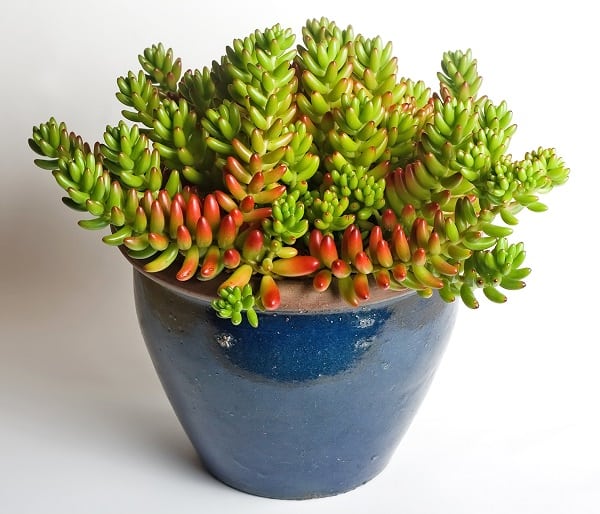The Sedum Rubrotinctum or commonly known as sedum pork and beans is a species of Sedum from the Crassulaceae plant family, native to Mexico.
It is a small succulent plant of rather creeping bearing up to 20 cm high.
Its leaves are fleshy cylindrical and light green in color.
When its leaves receive adequate light, its tips take on a very beautiful reddish hue.
The flowers are yellow and star-shaped, which bloom in spring.
Sedum Rubrotinctum is a species that is characterized by forming very branched, thin, green and erect stems to decumbent, that is, as the plant grows, the weight of the foliage causes the stems to lean and lay on the substrate.
The steepness of the stems encourages the formation of roots and young shoots, allowing rapid propagation of the Sedum plants in the substrate.
Tips to take care of the Sedum Rubrotinctum
This plant is a succulent that does not need great care, making it the perfect plant for those who want to start in the world of gardening.
And because of the peculiarity of its leaves, it is an ideal succulent for succulent collectors.
The sedum plants used in the rockery, succulent gardens and, above all, in pots and planters for terraces, balconies or as an indoor plant.
Substratum
The substrate can be a mixture, in equal parts, of garden soil, coarse sand and leaf mulch.
Or you can use a specific succulent substrate.
Regardless of what type of substrate you use, you should ensure that it has good drainage because sedum plant, like most succulents, is very susceptible to excess water and the roots of the plant can rot.
Illumination
The ideal exposure for Sedum Rubrotinctum is in full sun, but it can grow perfectly in semi-shade, the only disadvantage of the plant growing in semi-shade, is that the leaves will lose the reddish hue and will be green.
Temperature
Sedum Rubrotinctum is very tolerant of sun and drought but needs protection against frost.
But Sedum Rubrotinctum can easily tolerate winter indoors, as long as it is in a pot with a drainage hole and a sandy soil with good drainage.
The maximum temperature that tolerates the plant is -3ºC.
Irrigation
Water regularly in summer waiting for the soil to dry before watering again the Sedum Rubrotinctum and reduce the risks until in winter they are 3 or 4 waterings per month.
Fertilizer
Although Sedum Rubrotinctum does not need subscribers, it is good to add a low concentration mineral fertilizer added monthly during spring and summer.
You can also use a specific fertilizer for cacti and succulents, following the instructions on the packaging.
Pruning
Sedum Rubrotinctum does not require any pruning.
Only if the leaves of the plant are battered or damaged, if this is the case you should only cut the battered leaves.
Plagues and Diseases
Sedum Rubrotinctum can be attacked by fungi if we overdo it with irrigation and, sometimes, by aphids and mealybugs.
Propagation
Sedum Rubrotinctum can spread perfectly through its leaves. Just turn the stem leaf gently.
Make sure that the leaf you get from a clean tug, that is, that there is no part of the leaf on the stem because doing so will give you a better chance of making a successful spread.
You can also use the leaves that fall from the Sedum Rubrotinctum without any problem.
You just have to make sure that the Sedum Rubrotinctum does not drop the leaves due to excess water.
After obtaining the leaf, you should let the leaf become callous for a day or two before placing it on a special substrate for cacti and succulents with good drainage.
